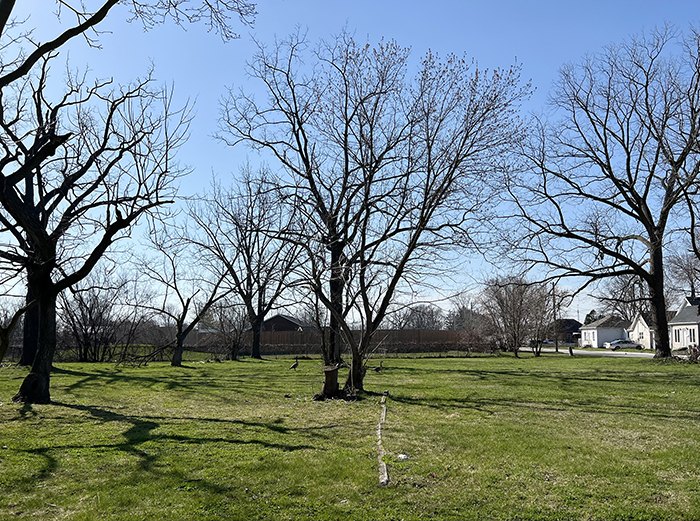
By Pam Wright
Local Journalism Initiative Reporter
Chatham-Kent council has paved the way for a new 50-cabin, tiny-home emergency shelter complex.
At the April 8 meeting, council passed a number of recommendations connected to the development, with a focus on providing community supports to those in need.
Dubbed the Emergency Transitional Cabin Program, the project will be located on a vacant 0.83-acre property owned by the municipally at the intersection of Park Street and Hyslop Street in Chatham.
The site is directly north of the Pet and Wildlife Rescue property and will include a communal building for washrooms and a kitchen, as well as the individual cabins.
Next steps for the shelter project include consulting. with neighbours so the municipality can best accommodate their needs moving forward.
“With council’s approval, municipal staff will be launching this important housing program as quickly as possible,” said Josh Myers, C-K’s director of housing services. “This program will give C-K residents who are experiencing homelessness, the opportunity to heal, learn new skills and be connected with other supports that are needed to change their future. The first thing we need to do is we need to listen.”
According to an administrative report, more than 25 municipally owned sites were considered in an “exhaustive search,” with the decision based in part on the location not being adjacent to an elementary school, splash pad or wading pool or licensed daycare centre.
The site is also close to a convenience store, bus stop and within a kilometre and and a half from a laundromat, Outreach for Hunger, ROCK Missions and Hope Haven. The complex will also have 24/7 security.
Next steps approved by council entail pre-site development work; hiring a project manager to assist with the cabin project which includes working on other affordable housing initiatives, as well as issuing requests for proposal for both construction and security services.
Council has also entered into agreements with ROCK Missions, Canadian Mental Health Association Lambton-Kent and Hope Haven to provide support and housing outreach services. A Chatham-Kent Legal Clinic housing stability worker will be hired as well.
Time is of the essence, officials said, as the contract at Victoria Park Place on Murray Street ends in May 2025.
Chatham Coun. Marjorie Crew said that while the cabin project won’t reach everyone – particularly those who don’t trust government – “Most people are supportive,” Crew said, including neighbours of the new site.
“They understand transitional housing. When people are down and out, we usually don’t count them out,” Crew said. “We try to help them out.”
She said that while nobody wants shelters, homelessness is a reality the municipality must deal with.
“Human issues are very expensive issues,” she told council.
Chatham Coun. Alysson Storey said the municipality cannot afford to “wait any longer” on the issue, noting the voices of the most vulnerable need to be heard.
Mayor Darrin Canniff said the cabin plan is a great step forward.
“This is progress; this is Chatham-Kent looking to implement a progressive solution to a very difficult issue,” he said, calling housing a “fundamental need.”
The transitional cabin project caps off a tumultuous period that saw C-K’s homelessness crisis deepen as a result of the pandemic. Council has recognized that the need for emergency shelter continues to mount and as a result directed municipal staff to come up with a plan for the future.
Since Chatham-Kent started providing shelter services two and a half years ago, 491 people have accessed the services, with 28,072 overnight bed visits provided, the report said. A total of 162 people have secured permanent housing following their shelter stay.
Council heard that folks staying at the cabin site must sign a participation agreement, whereby they agree to co-operate with a community worker to set goals which ultimately will lead them to permanent housing. If they don’t want to follow the plan, they will have to leave.
“Our goal is to end homelessness as quickly as we can,” Myers said, noting that making services more available helps alleviate difficult problems such as homeless encampments.
He emphasized that the new development is designed to provide transitional housing, not to build a permanent community.
Two deputations, one for and one against, were presented to council at the meeting.
PAWR operations manager Myriam Armstrong told council that while the organization supports a plan for emergency shelter, she doubts the municipality will be able to pull it all together by the May 2025 deadline.
Armstrong said PAWR staff are stressed about security concerns, adding the location of the tiny cabin development is a “poor choice.”
On the flip side, ROCK Missions executive director Renee Geniole also spoke on the issue, saying the entirety of ROCK Missions is excited about the tiny cabin plan, calling the site location “the last obstacle.”
However, Geniole acknowledged there will be “pushback” no matter where the homeless shelter is located.






